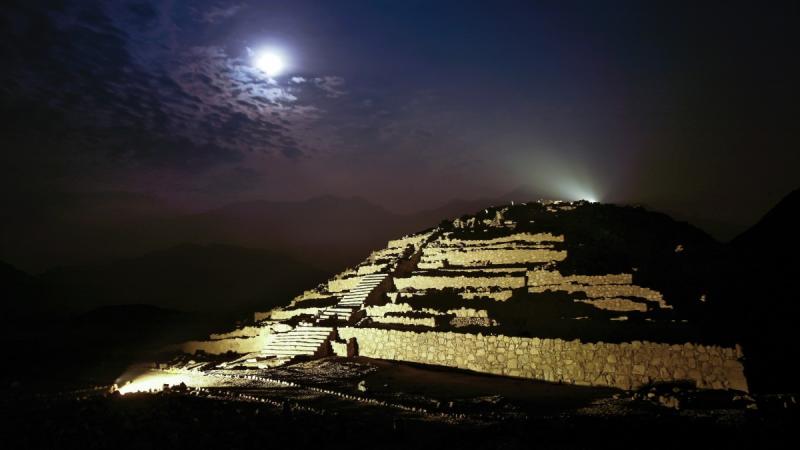This Little-Known Peruvian Civilization Built Pyramids as Old as Ancient Egypt's - HISTORY



Caral was an architectural marvel—a 1,500-acre complex constructed by the oldest known civilization in the Western Hemisphere. Author: Ratha Tep
Imagenes del Peru
Caral was an architectural marvel—a 1,500-acre complex constructed by the oldest known civilization in the Western Hemisphere.
Colossal pyramid structures in the Americas as old as those in Egypt? The Sacred City of Caral-Supe, in central coastal Peru, boasts an impressive complex of ancient monumental architecture constructed around 2600 B.C., roughly the same time as the earliest Egyptian pyramid. Archaeologists consider Caral one of the largest and most complex urban centers built by the oldest known civilization in the Western Hemisphere.
The 1,500-acre site, situated 125 miles north of Lima and 14 miles from the Pacific coast, features six ancient pyramids, sunken circular plazas and giant staircases, all sitting on a windswept desert terrace overlooking the green floodplains of the winding Supe River. Its largest pyramid, also known as Piramide Mayor, stands nearly 100 feet tall, with a base that covers an area spanning roughly four football fields. Radiocarbon dating on organic matter throughout the site has revealed it to be roughly between 4,000 to 5,000 years old, making its architecture as old—if not older—than the Step Pyramid of Saqqara, the oldest known pyramid in ancient Egypt.
That remarkable discovery places Caral as one of the oldest known cities in the Western Hemisphere. Coastal Peru has long been considered one of the six recognized cradles of world civilization, and new archaeological discoveries continue to push back the dates of when the region's "mother culture" was established. Caral was the first extensively excavated site among some two dozen in a zone along Peru's central coast known as the Norte Chico area. Archaeologists believe the sites collectively represent the oldest center of civilization in the Americas, one which lasted from roughly 3000 to 1800 B.C., completely uninfluenced by outside forces. It flourished nearly 4,000 years before the start of the powerful Incan Empire.
READ MORE: Ancient Native Americans Once Thrived in Bustling Urban Centers
Its Age Wasn't Initially Clear to Scientists
View of one of the amphitheaters of the Caral archaeological complex, in Peru. Almost 5,000 years old, it was built by one of the oldest cultures in the world.
ERNESTO BENAVIDES/AFP via Getty Images
Despite Caral's significance, decades passed between when the first scholars stumbled upon the area, and when they recognized its importance. German archaeologist Max Uhle explored the Supe Valley, but not Caral itself, as part of a wide-ranging study of ancient Peruvian cities in the early 1900s. But it was American historian Paul Kosok, who is largely recognized as the first scholar to recognize and visit what is now known as the site of Caral in 1948. In his 1965 book, Life, Land and Waterin Ancient Peru, he referred to the site as Chupa Cigarro Grande, after a nearby hacienda.
The sheer size and complexity of the site, however, led many to believe Caral's structures were made only more recently, largely leaving it to go ignored. It was only in 1994, when Peruvian archaeologist Ruth Shady of National University of San Marcos started studying the site, that she realized, in the absence of finding any ceramics, that Caral might date before the advent of pot-firing technology.
But Shady needed to substantiate her claims. While excavating the largest pyramid, she and her team found the remains of reed-woven bags, known as shicras, filled with large stones to support the pyramid's retaining walls. In 1999, she sent the reed samples for radiocarbon dating to veteran archaeologists Jonathan Haas, at Chicago's Field Museum, and Winifred Creamer, at Northern Illinois University.
The results, published in the journal Science in April 2001, were monumental. Caral, along with other ancient Norte Chico sites in the Supe Valley were "the locus of some of the earliest population concentrations and corporate architecture in South America," they wrote. At that time, Caral was hailed as the oldest known city in the hemisphere; since then, other Norte Chico sites, dating several hundred years earlier, have been unearthed—and discoveries continue.
READ MORE: Nazca Line Discoveries in Peru Suggest the Mysterious Geoglyphs Are Pervasive
The Massive Complex Signals an Advanced Society
Shady, who heads the Caral-Supe Special Archaeological Project, has continued to probe the depths of the long-lost ancient city—which, compared to some highly looted archaeological sites, had remained relatively untouched due to its late discovery. Her finds have revealed a site of epic proportions, one that not only looms large with its massive pyramids, but with other architecturally complex elements including extensive residential units, multiple plazas and an impressive sunken circular amphitheater that would have been large enough to hold hundreds of people. It was there that Shady and her team unearthed the remains of dozens of flutes made of pelican bones, relics of the importance of music to the ancient people of Caral.
Another significant find came in the Gallery Pyramid (or Piramide de la Galeria), which reaches 60 feet tall. On the twelfth step of its central stairway, archaeologists unearthed a quipu, an ancient method of recording information used through Incan times, believed to be among the oldest discovered in the Americas.
That such a highly structured society existed implied the presence of strong leadership and thousands of manual laborers. "In order to set up this city and its monumental buildings according to a coordinated design, prior planning, experts and a centralized government were necessary," wrote Shady in "The Sacred City of Caral," a nomination file submitted to Unesco, which inscribed the archaeological site onto the World Heritage List in 2009.
READ MORE: Pyramids in Latin America
Why It Was Abandoned Remains a Mystery
Stairs to one of the pyramids of the Caral archaeological complex
ERNESTO BENAVIDES/AFP via Getty Images
The existence of such a large and well-organized inland civilization has helped smash the "maritime hypothesis," or the long-running theory that complex Andean societies evolved first from the coast, where they were heavily reliant on fishing, and only later progressed inland. Dr. Shelia Pozorski, and her husband, Thomas, professors emeriti at the University of Texas Rio Grande Valley, questioned the maritime hypothesis as early as 1990. But it wasn't until "archaeological evidence and dates for Caral and other Norte Chico sites became available, that the 'maritime hypothesis' was more soundly refuted," she said. Coastal settlements and inland ones existed and developed at the same time, with Caral larger and more complex than any coastal villages that may have existed in the area before.
The discovery of cotton seeds, fibers and textiles, along with the remains of clam shells and fish bones at the site—as well as a large fishing net that was as old as Caral, found along the coast—helped Shady formulate another theory: The farmers at Caral grew and traded cotton in exchange for fish and shellfish from the villagers along the coast. The end result: production surpluses, local labor specialization and the emergence of political authorities in charge of trading. In short, Caral had a burgeoning model of social and political organization.
While much is known about Caral, perhaps there's more that's unknown—including why it developed in such a complex manner, and its relationship to the other ancient Norte Chico sites.
The largest mystery, however, might be why it was abandoned after being inhabited for nearly a thousand years. "There is no concrete evidence indicating that a single event, like an earthquake or large flood, ended the occupation of Caral," Dr. Thomas Pozorski says. "It is much more likely that several factors contributed to the decline of the state, including internal strife and discord which is very difficult to prove in archaeology."



A highly complex and advanced civilization that just disappeared.
Tribes in what is now Peru practiced mummification thousands of years before the Egyptians.
I'm probably wrong but I like to think that given the long history of pyramid building in the Americas that their civiilization splintered with some evolving into later great civilizations (Toltec, Olmec, Zapotec, Mixtec, Aztec among many others)
Great seed like you I love this stuff
It certainly is possible that they later became part of another group, perhaps someday we'll find out.
The highly advanced Mississippian culture the Cahokia simply disappeared and they really have no idea what became of them. Their time period was 800AD to 1400 AD.
I stumbled across another article a few days ago and I'm trying to find it again and will post it. The great mound builders of Poverty Point.
Free - if you get the chance, Charles Mann wrote "1491" and pretty well describes what you referenced. Jack Wetherford wrote two books dealing with the same timelines/accomplishments.
Anoon first...sorry completely off topic...but did you get your new kitty?? Been busting to know...
I actually watched the 1491 series on APTN a couple years ago but will definately pick up the book as they are usually better and more detailed than tv
Yeah - I'm spoiled and the vet and bank love me Stormy and Wessy.
Stormy and Wessy.
Free -
The two Jack Weatherford's are "Indian Givers - How the Indians of the Americans Transformed the World", 1988, and "Native Roots - How the Indians Enriched America", 1991. Thoroughly enjoyed them.
They're on the list
Now I wonder in which country the earliest civilization existed. I thought China and Egypt were early civilizations but this could be earlier.
It definitely is one of the oldest civilizations ever to exist.
You should read about Newgrange, a neolithic structure located in the Boyne River Valley near Dublin that we visited when we were in Ireland. Newgrange was constructed in 3200 B.C. It is older than the oldest pyramids in Egypt and is 1,000 years older than Stonehenge. It is one of the most amazing places I have ever been.
Yep, that's pretty ancient. (could not open the YouTube),
It's too bad you can't open the YouTube. It shows the stone ceiling in the central chamber, which is absolutely beautiful.
I'm planning to see Newgrange next summer. Waiting on my passport...
You will love it. They have a very interesting visitor center/museum at Newgrange, also.
Ireland is one of my favorite places I have visited. It's beautiful, historic and everyone is very friendly. Great, great place.
"1491" comes to mind when reading this as Mann also mentioned it along with its age and construction.
It is reminiscent of Mann and 1491.
Good read, Kav! Thanks for seeding it
Your welcome, Trout.
ditto. I really like how it also blows away the whole garden of eden, center of creation premise too. my DIL is peruvian and my grand daughter is half peruvian, and half hellion. first new NA blood in the family for about 300 years. bilingual at 3 years old, she's my interpreter for the other side of the family when her mom isn't around.
Around 80% of Peruvians identify as indigenous or Mestizo.
You're now in very good company, devan.
Great article, Kavika, thank you for seeding it. It is not only very interesting, but, also very enlightening in regards to the history of mankind. And is right up my alley of ancient history. I find it most interesting how we continue to find new levels of growth of humans that continues to expand world civilizations and their footprints on history.
Happy that you enjoyed it RW.
I love this type of thing, as you do.
Americans are largely pretty ignorant of anything to do with South American history. Its a hard sell to the general public.
Very interesting story.
the RCC sponsored genocide of south american cultures was pretty much over before there was a US.
Not only south American cultures but cental and North American cultures, the trifecta.
This civilization rivaled anything from Eqypt or China and it seems at least as old if not older.
Not only South America but Central and North American indigenous history.
This civilization rivaled anything on earth at the time.
Survivors of the last outposts of the aliens?
Golden toys of aircraft ( or birds ) from Columbia ?
or representative of some ancient air force ?
Ancient Aliens.
don't even get me started on that...
The Star People
Jewelry made to stay flat on your chest, the "tail" vertical to give more dimension but left flat on the bottom to avoid it digging into your chest, and designed as a bird or fish or combination of both.
Didn't they believe that comets, planets, meteors were travelers of the skies, what a better way to get their attention.
Not meaning to start a fight or anything, but Americans are pretty ignorant about a lot of things.
Great seed, Kavika. Extremely interesting.
Thanks G, happy that you enjoyed it.
The people of Caral-Supe were some clever folks.
They sure were clever, some might even call them “really smart guys and ladies”
Very interesting. I think it's time for me to do one of my deep dives if I can find some time. I'd like to know the theories on where the people went? Was there a drought or war? Disease? Why was it left for the jungle to swallow?
There have been many more discoveries using lidar that has found lost cities/civilizations in both central and south America in the last few years.
Yeah. I've been following a few of those stories where they use lidar on drones to help map out these buried cities.
Excellent link, EG.
I first came across Caral in an article and YouTube video some years ago. I'm not sure, but isn't Caral the place where no weapons of war were found?
You are correct, Steve. No weapons, battlements or bodies that showed death from war.
Whew. Nice to know that some of my memory is still working. It is fascinating that in the face of the overriding theory the war created civilization, a civilization was created without war. I have to say, indigenous peoples, have much to teach the world.
Thanks for the post Kavika.I really enjoy this kind of stuff.
Here is another one you'll enjoy.